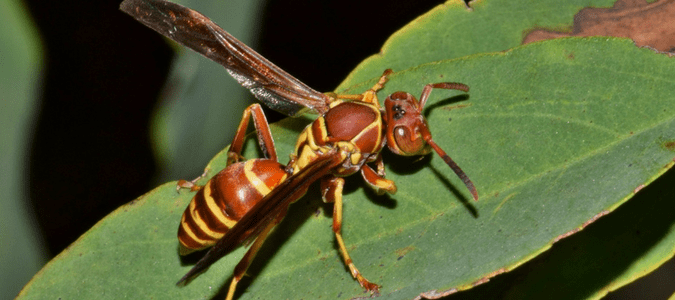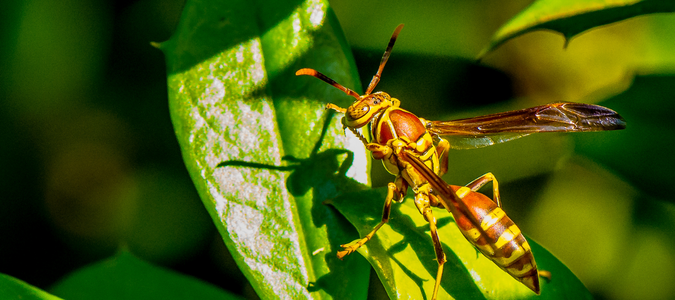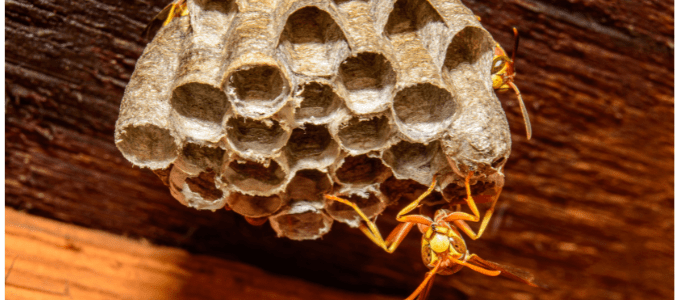There are over 100,000 species of wasps, making it hard for homeowners to tell them apart and identify which species are taking up residence on their property. However, some wasps are known for their extra-long legs that set them apart from other species.
If you have a wasp problem on your property, the best thing you can do is call in professional help. Contact a pest control specialist if you are dealing with a wasp infestation.
What Is the Species of Wasp With Long Legs?
The type of wasp known for its long legs is the paper wasp species. These wasps are also known for having very slender bodies. Their bodies typically measure one to one and a half inches long and have thin waists separating their thorax and abdomen.
Paper wasps also have two pairs of elongated wings. The first pair is slightly longer than the second. They are usually brown in color with some yellow spots, and some paper wasps may be black.
Paper Wasp Behavior and Colonies
These wasps are highly social insects that live in large structured colonies. They build nests out of chewed-up wood fibers, which is how they got the name paper wasp. They like to build their nests in protected areas, such as large trees, shrubs, roof overhangs, attic rafters, under decks or on window and door frames.
Their colonies consist of a queen paper wasp responsible for maintaining the colony. The queen is larger than the other paper wasps and is the only female that reproduces.
Next, there are worker paper wasps, which are female wasps that do not reproduce. They are responsible for foraging for food, building the nest and caring for the young. Lastly, there are male paper wasps who are responsible for mating. After mating successfully, the males die.
Paper wasp colonies have an interesting way of communicating with each other using a variety of vibrations and chemical cues. They do this to conduct daily operations and alert each other of threats.
Paper Wasp Life Cycle
The paper wasp colony starts with the queen. Queen paper wasps emerge from hibernation in the springtime and begin constructing a new nest. They lay their first round of eggs in the nest, which hatch into larvae.
The paper wasp larvae go through a pupa stage before maturing into adults. All the wasps from this cycle become worker paper wasps who help maintain the colony. They take over the duties that the queen was doing, and the queen’s new role is solely to reproduce.
At the end of the summer, the queen will lay eggs that become future queens and male paper wasps. These wasps mate with each other, and the male dies shortly after. The new queens hibernate in the springtime. The rest of the colony dies in the winter, and the whole cycle starts again when the queen emerges from hibernation in the spring.
Paper wasps do not reuse old nests from previous colonies, so the new queens must construct a new nest to start the cycle over again.
If you have paper wasps on your property that you want help with, contact an expert pest control service.
Do Paper Wasps Sting?
Paper wasps are generally non-aggressive; however, they will sting when they feel threatened. Paper wasps sting humans or other animals to defend themselves and their colonies. Their stings are often painful for humans and can cause swelling, redness, pain and itchiness.
If you get stung by a paper wasp, apply an ice pack to the area to help the swelling go down. Do not disturb their nests to avoid getting stung by a paper wasp. Instead, contact a pest control specialist to deal with the infestation.
Even though getting stung by a paper wasp is rare, there are other ways these pests can become a nuisance when they reside on your property. For example, they will eat fruit from your garden because they are attracted to sugary substances.
Paper wasps often scrape wood off of homes to construct their nests. Even though it’s rare, they can chew through the drywall. Their nests are also unsightly for homeowners and often in annoying places, such as entryways, windows and outdoor living spaces.
Make Your Home Less Appealing to Paper Wasps
There are several ways that homeowners can deter a paper wasp colony from setting up camp on their property by making the area less appealing. First, seal up entry points into your home so they cannot enter your house. This includes cracks and holes around your doors, eaves and windows.
Next, don’t give paper wasps food options on your property. Keep your indoor and outdoor trash, recycling and compost bins properly sealed with an airtight lid. Do not leave uncovered food lying around, especially outside.
If you have fruit trees, clean up fallen fruit right away. Keep your trees and shrubbery trimmed back to limit their potential nesting sites. You can also plant flowers and plants that deter paper wasps. These pests do not like the scents of spearmint or marigold, so planting them around your garden may help keep them away.
While paper wasps are not an aggressive wasp species, they are still not pleasant to have around your home. If you see an active paper wasp nest on your property, reach out to a pest control specialist to get rid of wasps.
Paper Wasp Nest Versus Hornet Nest
Paper wasps and hornets are often mistaken for one another but have several key differences. One of the biggest differences is the paper wasp nest versus the hornet nest.
Paper wasp nests are shaped like an umbrella and made of wood fibers that are chewed and mixed with saliva to create a papery thin material. Paper wasp nests are attached to protected areas like eaves and window frames. They also have hexagon-shaped cells that are visible from the outside.
On the other hand, hornet nests are enclosed structures that are rounder than paper wasp nests. Hornets also build their nests in protected areas like tree branches and wall voids. They also use chewed-up wood mixed with saliva to construct their nests; however, their nests have a thicker outer layer, providing more protection.
Hornet nests have a small opening on the bottom that serves as the entry point. The nests have multiple layers and chambers but are not as visible as the cells in a paper wasp nest.
How to Get Rid of Paper Wasp Nests and Hornet Nests
If you attempt to remove a paper wasp or hornet nest on your own, it’s important to do so safely. Both species will sting humans when they feel threatened.
If you want to relocate the paper wasp or hornet nest without disturbing the insects, ensure you do it at night when they are sleeping. Wear long sleeves and pants and a protective face covering in case they try to sting you.
You can also use the nest-drenching method to spray the nest with insecticide. Another similar option is the nest dusting method, where you drop the insecticide powder straight into the nest’s opening. Once you have applied the treatment, remove the nest and discard it.
It’s important to be extremely cautious around paper wasp and hornet nests. It’s best to leave removal to experienced pest control experts instead of trying to do it yourself. Call a pest control service today if you have a paper wasp or hornet problem on your property.
Get Rid of Paper Wasps With Professional Help
Paper wasps are known for their long legs and intricate nests. Thankfully, they are mostly non-aggressive pests and only sting when they feel threatened.
You can do several things to make your property less appealing to paper wasps. However, the best way to deal with an infestation is to reach out to an expert pest control service.
It’s common to confuse paper wasp nests and hornet nests. An expert can identify your infestation and safely remove the nest so you don’t have to worry about getting stung. Contact a pest control specialist today to deal with your wasp problem.
ABC Can Treat the Wasp Nests on Your Property
Having a wasp nest on your property can be frightening. Instead of trying to handle the problem on your own, contact ABC Home & Commercial Services. Our pros can offer advice on what attracts wasps, and we can effectively remove these pests, so you don’t have to worry about painful stings.


